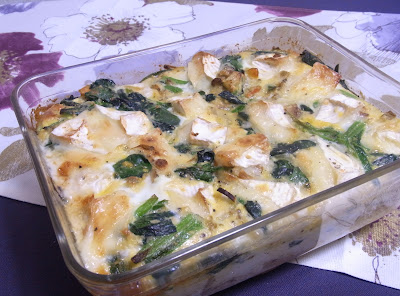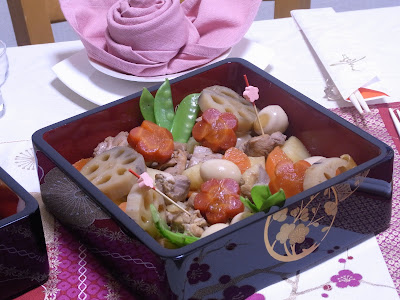 |
| "Scented breeze across hills of spring verdure": see the little napkin and menu "hills"? |
I had been lurking at the inspiring food and table blog Lovely place for some time, admiring the table coordination lesson pics, when it struck me that I could probably track this class down and attend myself. And with a bit of sleuthing, I did!
ATELIER Let's Have a Party! is run by a one-woman dynamo whose unassuming air belies a kick-ass knowledge of all aspects of entertaining, from flower arrangement, to table decorating, to meal planning. She makes her own table cloths, napkins, decor items and, having previously been a pottery teacher, even some of the tableware! She also has a deep knowledge of the sophisticated world of traditional Japanese colours. It is like a whole new language that I hadn't come across before as a Japanese-English translator. Actually, even the themes for her lessons are beautifully poetic and I'm having real trouble translating them into similarly poetic English. Long story short, I really like Oba-sensei's style!
 |
| Place setting |
This is was my second lesson, after being thoroughly impressed at April's cherry blossom-themed class. This time, the theme was, pardon my translation, "Scented breeze across hills of spring verdure: Entertaining on the 88th day of spring." Inspiration came from the tiered rice paddies traditionally planted and new green tea traditionally harvested around that date (May 2 this year), which is marked on the traditional Japanese calendar as a time when the seasons change. It certainly felt like early summer the day my friend and I took the lesson!
After a short introduction to the day's theme, explanation of the specialist terms and concepts (not only for my benefit ; )), and rough overview of the cooking portion of the class; we got to work. First the flower arranging, then setting the table, then the cooking, and finally, the eating : )
 |
| Nori-dusted pork parcels with green tea salt |
Spring veggies in a kombu-cha dressing
Ginger-sesame salmon rolls
Green tea soba salad with tomato-wasabi dipping sauce
Nori-dusted pork parcels
Served with: Chilled green tea and an unsweetened matcha liqueur
All were delicious, but I got particularly excited by the salmon rolls and that tomato-wasabi dipping sauce. Those big, punchy flavours are right up my alley!
Sensei buys in dessert. This time it was (from left to right) matcha waffle, matcha and nut yokan (hard jelly), and nori-scented rice puffs. A lovely blend of sweet and savoury flavours that echoed the tea-and-sea aromas of the rest of the meal.
 |
| Sweet and savory dessert in green tea and nori flavours |













